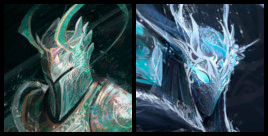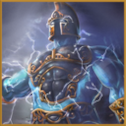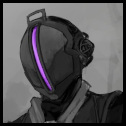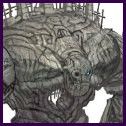Empyrean
 "Male" / "female" Empyrean. | |
| Details | |
|---|---|
| Faction | Isegrád |
| Lifespan | ??? |
| Population | Extremely Low |
| Average Height | ??? |
Carved of stone and forged of magic.
Of Rhyst's races, none are less common than the Empyrean. Their (publicly reported) numbers total less than a hundred, though they make up for it with their sheer competency. They are literally carved from solid blocks of mana-infused stone, made to be utterly dense beyond comparison, before having their silhouette framed with gold strips and various other metals. Ironically, the gold is the least expensive component of their design. It is said that the only thing stopping Isegrád from building an army of Empyreans is the overwhelming cost associated with it, given the rarity of the ingredients and a few other factors that they, to put it lightly, won't publicly disclose.
Appearance
Empyrean vary in appearance almost as much as Hedera, though in different ways. Given that Empyreans are created by the same "line" of crafters, they share a similarity between them that Hedera don't need to. Still, everything afterwards is up in the air, as Empyreans- or even their companions- may end up modifying their body in various ways to make them better suited for different tasks. Generally, they all maintain pale, stony skin and metal framing with an emphasis on regality. They are intended to look professional and royal, given that their unspoken role in Isegrádian society is to protect generals, leaders, and politicians.
Culture
Empyreans are the newest race on Rhyst, literally so. They came to fruition merely eighty years prior to the venture to the island, though they've technically existed for a hundred years prior- they just hadn't been confirmed yet. Regardless, Empyrean culture tends to resolve around servitude, though it comes in many different forms. Some are bound to a specific family and serve almost as a member, while others are guardians of a single politician and act as their bodyguard instead. The role they play is entirely dependent on their surroundings.
A particularly interesting facet of their abilities is that they're uniquely adept at manipulating mana. Sorcery exists, of course, but Empyreans are imbued with this ability as something of a birthright. Simply by existing, they absorb and churn out mana like mobile beacons. Some believe that they're built this way intentionally, such that they're specifically very good at fighting Sorcerers and Weavers- the most prominent types of mages in Isegrád- rather than outside forces. They're nonetheless fantastically useful for the latter cases too, but the suspicion remains.
Though given that they've been shipped to the island with everyone else, those that've arrived there have a certain degree of freedom and individuality that has never been awarded to an Empyrean prior. It is common for Empyreans to be called by their "number", or, more specifically, which Empyrean they are in order from one to, well, the newest.
The Emerald Heart
In the time leading up to the venture to the island, though, Empyreans still found ways to collaborate in their off hours. It is then that they researched their origins and spread knowledge among themselves of where they came from, but- even with this extensive effort, what's known to them is nonetheless hazy. The only assured fact that each can recall is what they've since deemed the "Emerald Heart", a pulsing orb of green flame and energy buried deep in their memories. It isn't written about in any public Isegrádian texts, nor has it been recorded elsewhere either as some sort of otherworldly artifact.
However, if one delves deeply enough into the legend of Isegrád's beginnings, and if one abuses their connections and trustworthiness to get information... There are hints- inklings, if anything- of such a thing originating some decades after the city's first years. It is reportedly locked away in the darkest corner of Isegrád's furthest dungeon in the equivalent of a padded cell, for whatever reason. As of late, fewer Empyreans have been made, and many turn to this modern fairy tale as something of a clue as to what's really going on behind the scenes.
The Empyrean Order
VII (7)
It is unknown the exact year that VII was forged, but their reputation is one of great renown. Given the rank of High Inquisitor within the Empire They were supposedly incapable of being hit by magical blows, proving completely immune to mana-reinforced strikes and spells in general. If that wasn't enough, they were perceived as the right hand of the High Magister and VII was seen, rarely so, on battlefields by his decree. It is no surprise that these tales only returned from the men on Isegrád's side.
XI (11)
Forged in the year 970, XI, known as Locus, was an Empyrean built for preserving the peace of Isegrád, the stocky model predates numerous aesthetic improvements that are present in later iterations. Lacking visible human traits, this creation's focus was on defeating the enemies of the Empire with little in the way of apparent capacity for independent thought. It was sent to the colony of Providence in year 1000 to ensure the colony's protection.
XVI (16)
Forged in the year 972, XVI was an Empyrean of special design, XVI went by the name of the nobleman it was meant to resemble. Drahcir Redgrove stood at six feet tall and was made of bronze metal. His likeness was that of a human, as he was constructed in the image of his creator's deceased son. He learned to weave the arcane with great proficiency, often considered a master in the field.
XVII (17)
Forged in the year 972, and an odd addition to the ranks of the Empyrean, XVII went by his numeric name and claimed to be a prophet for the Emerald Heart. He constructed a church focused on this belief and began to preach this faith as a modern religion to any who would listen. The religion was focused on imperial tenets and beliefs, but also tried to teach what it meant to be an Empyrean. XVII dubbed himself the Arbiter of the Verdant Flame and brought his Church to the colony of Providence in the year 1000.
XXVI (26)
Forged in the year 974, XXVI was an experiment in the creation of Empyreans. Instead of using the natural ores with mana, his entire body was made out of the ground, rocks from an old graveyard that had mana infused stones made out of the leftover energy of corpses. He looked a bit monstrous, but he was just a researcher who kept to his duties of ensuring the progress of the Empire.
LXXXI (81)
Forged in the year 979, LXXXI was a peculiar Empyrean. A very individualistic model, this Empyrean had a love for explosions, and due to his focus on demolitions and creation, he was sent on the Sarean expedition as a Forgemaster in the year 1000. Adopting the name DI, or 501, he somewhat rebelled against the typical Empyrean naming scheme in favor of calling himself and other experiments of his 'Mana golems'.
Trivia
- Many assume the Empyrean were intended to be a vessel for another living being at first.




